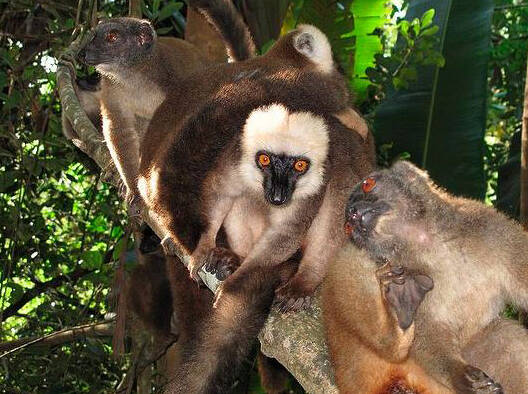Eulemur albifrons
IUCN
LCBasic Information
Scientific classification
- name:Eulemur albifrons
- Scientific Name:Eulemur albifrons,White-fronted Lemur,White-fronted lemur, White-fronted brown lemur
- Outline:Primates
- Family:Lemuridae Lemuridae
Vital signs
- length:39-42cm
- Weight:2-2.6kg
- lifetime:About 30 years
Feature
The males have a distinctive ring of white hair around their faces, covering their forehead, crown, beard and throat.
Distribution and Habitat
The white-headed lemur is limited to northeastern Madagascar. It inhabits tropical rainforests, moist montane forests, and dry deciduous forests. The lemur is arboreal, spending most of its time in the upper canopy.
Appearance
The white-headed lemur is a medium-sized lemur. The head and body are 39-42 cm long, the tail is 50-54 cm long, and the weight is 2.0-2.6 kg. The tail is longer than the body, with dense hair and a broom shape; the eyes are large; the fur is dense and brightly colored; the upper body color ranges from brown to yellow or black, the fur on the back is brown-gray, and the ventral side is grayish white. The tail is darker in color, the face is black, and the muzzle and crown are usually dark, ranging from dark gray to black. There are light spots above the eyes. The male has a circle of bright snow-white whiskers around the face, surrounding the forehead, crown, beard and throat. The female's head, face and muzzle are dark gray, but the cheeks do not have the dense whiskers of the male. The lower body is slightly gray. There is pale gray-brown fur around the ears, cheeks and under the chin. The tail is densely furred and the back is arched when moving on the ground or branches. The ey
Details
The white-fronted lemur (scientific name: Eulemur albifrons) is a medium-sized lemur. It was once a subspecies of the brown lemur (Eulemur fulvus) and was established as an independent species in 2001.

White-headed lemurs are active at different times throughout the day and night. They live in groups, but the groups are not fixed. Sometimes the group is 3 to 12 individuals, usually 5-7 together. Each individual smears urine on the body as a scent identification. The territory overlaps, but adjacent groups generally avoid contact. They are highly adaptable to the forest.
The white-headed lemur forages in trees or on the ground. It is omnivorous, and its main food is fruits, mature leaves, flowers, bark, sap, soil, insects, centipedes, and millipedes.
The reproduction of the white-headed lemur is seasonal, and mating usually occurs in May and June. The gestation period is about 120 days, and the cubs are born before the rainy season in September and October. Generally, only one offspring is born per litter, and there are also reports of twins. The white-headed lemur reaches sexual maturity in 1-3 years, and its lifespan in the wild is about 30 years.
The distribution range of the white-headed lemur is limited. Due to the loss of habitat, the species' living environment is seriously threatened. It is believed that the number is in a clear downward trend and has been listed as an endangered species. It mainly lives in four national parks (Ankarafantsika, Mantadia, Andringitra and Zahamena), two strict nature reserves (Tsaratanana and Zahamena), and seven special reserves (Ambatovaky, Ambohitantely, Analamazaotra, Bora, Mangerivola, Manongarivo and Tampoketsa -Analamaitso) in the Falkland Islands.
Listed in the 2014 Red List of Endangered Species of the World Conservation Union (IUCN) ver 3.1 - Endangered (EN).
Listed in the CITES Appendix I of the Washington Convention on International Trade in Endangered Species.
Protect wild animals and stop eating game.
Maintaining ecological balance is everyone's responsibility!








